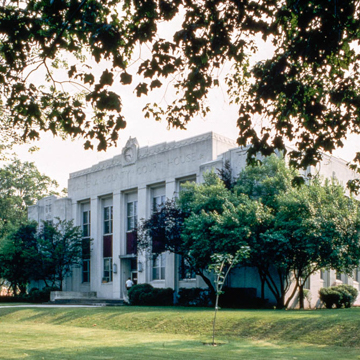Designed by Kuni of Detroit, and financed by loans and grants from the Public Works Administration (PWA), the Alpena County Courthouse is an example of “pump priming” in the Great Depression period. Moreover, the construction of the courthouse used local materials and local labor. The Henry C. Weber Construction Company of Detroit, pioneers in the use of reinforced-concrete construction technology, poured the concrete made with Huron Portland cement for the two-story, fireproof monolithic courthouse during the extremely cold temperatures of Alpena's winter months. The concrete was then sandblasted and treated with “Restocrete” to enrich its color; a chemical waterproofing agent was also used.
Situated in the center of a grassy terraced square planted with trees, the courthouse is modernistic, with its flat roof, vertical bays, fluted and reeded pilasters, steel-sashed windows, and eagle-topped, parapet-mounted clock. Sculptural decoration depicts the appropriate figures of Law and Justice; and the fascia designs show images of the county's lumbering, shipbuilding, farming, fishing, and recreational industries. The interior vestibule and lobby are decorated with zigzag and chevron motifs, and the terrazzo floor is inlaid with geometric patterns. An aluminum stairway with travertine marble treads has an art-glass window at the landing and the courtroom is trimmed in walnut.
One local writer dubbed the courthouse “Fort Alpena,” another thought it combined beauty, artistry, dignity, utility, and convenience, and the speaker at the building's dedication suggested that it was a mighty structure worthy of the inscription “Give Me Men to Match My Pine.”


